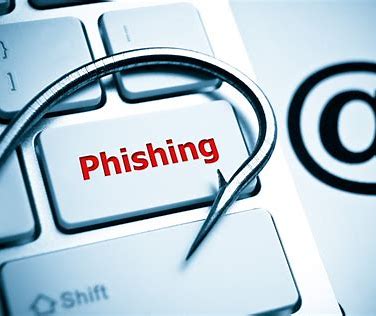Well, That Seems Phishy: The Importance of Not Falling for Email Phishing Scams


In our digitally connected world, the inbox is both a gateway to productivity and a potential minefield of security risks. Among these risks, phishing emails stand out as one of the most pervasive and dangerous threats. Despite advancements in cybersecurity, phishing attacks remain alarmingly effective, exploiting you to gain access to your sensitive information. But what exactly is phishing, why is it so dangerous, and how can you protect yourself? Let's dive into the world of phishing and uncover why it’s critical not to take the bait
What is Phishing?
Phishing is a type of cyber-attack where scammers impersonate legitimate organizations or individuals to trick recipients into providing sensitive information, such as passwords, credit card numbers, or personal identification details. These attacks typically arrive via email but can also occur through text messages, social media, or even phone calls. The goal is simple: to steal valuable data or install malware on the victim’s device.
The Anatomy of a Phishing Email
Phishing emails often appear remarkably authentic, mimicking the style and tone of legitimate communications from trusted sources. A typical phishing email might include:
· A familiar-looking sender: The email may seem to come from a well-known company, a government agency, or even a colleague. Scammers often spoof email addresses to make their messages appear more credible.
· Urgent or alarming language: Phrases like "Your account has been compromised!" or "Immediate action required!" are designed to create a sense of urgency, pressuring you to act quickly without thinking.
· Suspicious links or attachments: These emails often include links that lead to fake websites resembling real ones or attachments that contain malicious software.
· Requests for personal information: A classic red flag is a request for sensitive information, such as your password, Social Security number, or credit card details.
Why Phishing is So Dangerous
Phishing attacks are effective because they exploit human emotions and trust. Even the most tech-savvy individuals can fall victim to a well-crafted phishing email, especially if it arrives at a time of stress or distraction. The consequences of falling for a phishing scam can be severe, including:
· Financial loss: Scammers may use stolen information to drain bank accounts, make unauthorized purchases, or commit identity theft.
· Data breaches: For businesses, a successful phishing attack can lead to a massive data breach, exposing sensitive customer or employee information.
· Malware infections: Clicking on a phishing link or downloading an attachment can install malware on your device, potentially giving attackers control over your system or network.
How to Spot a Phishing Attempt
While phishing emails can be sophisticated, there are several telltale signs that can help you identify them before it's too late:
· Examine the sender’s email address: Look closely at the sender’s address. Scammers often use addresses that look similar to a legitimate one but may have subtle differences (e.g., "support@amaz0n.com" instead of “support@amazon.com").
· Hover over links: Before clicking on any link, hover your mouse over it to reveal the actual URL. If the link looks suspicious or doesn’t match the supposed destination, don’t click it.
· Check for grammatical errors: Many phishing emails contain spelling or grammatical mistakes. Legitimate companies usually have high standards for communication, so errors can be a red flag.
· Be wary of unsolicited attachments: If you receive an unexpected attachment, especially from an unknown sender, do not open it. It could contain malware.
· Verify through other channels: If you’re unsure about an email’s legitimacy, contact the organization directly using a phone number or website you know is legitimate. Do not respond to the email or use any of the contact information provided in the email.
Protecting Yourself from Phishing Attacks
To safeguard yourself from phishing scams, follow these best practices:
· Use email filters: Most email providers offer spam and phishing filters that automatically detect and block suspicious emails. Make sure these are activated on your account.
· Enable multi-factor authentication (MFA): MFA adds an extra layer of security by requiring a second form of verification, such as a code sent to your phone, before accessing your account.
· Keep software updated: Regularly update your operating system, browsers, and antivirus software to protect against the latest threats.
· Educate yourself and others: Stay informed about the latest phishing tactics and share this knowledge with family, friends, and colleagues. Awareness is one of the best defenses against phishing.
· Report phishing attempts: If you receive a phishing email, report it to your email provider, your organization’s IT department, or the appropriate authorities. This helps prevent others from falling victim.
What to Do If You Fall for a Phishing Attack
Even the most cautious individuals can fall victim to a phishing scam. If you find yourself in this situation, it's important to be embarrassed and to act quickly to minimize the damage. Here’s what you should do:
1. Don’t Panic, but Act Fast
The first step is to stay calm. Panicking can lead to hasty decisions that might make the situation worse. Some links will make alarm sounds come from your computer and tell you to call the number on your screen to save your personal data. Don’t fall for this! If your company has an IT department, contact them immediately.
2. Disconnect from the Internet
If you clicked on a suspicious link or downloaded an attachment, disconnect your device from the internet immediately. This helps prevent any malware that may have been installed from spreading further.
3. Change Your Passwords
If you entered your login credentials on a phishing site, change your password immediately! If you use that password on any other accounts change it on your other accounts as well. Use a strong, unique password for each account, and consider using a password manager to keep track of them securely. If possible, enable multi-factor authentication (MFA) on your accounts to add an extra layer of security.
4. Sign out of all Active Sessions:
Check if the website or account has an option to sign out of all sessions or revoke all active login tokens. This will log the attacker out of the account they got into. But remember to change your password so the attacker can’t log back in.
5. Monitor Your Accounts
Keep a close eye on your bank accounts, credit cards, and any other accounts that may have been compromised. Look for any unauthorized transactions or changes. If you notice anything suspicious, report it to your bank or service provider right away.
6. Contact the Relevant Organizations
If you’ve provided sensitive information like your Social Security number, credit card details, or banking information, contact the relevant organizations immediately. For example:
· Bank or Credit Card Company: Report the potential fraud and request a hold on your account or a new card.
· Credit Bureaus: Consider placing a fraud alert or credit freeze on your credit report to prevent new accounts from being opened in your name.
· Social Security Administration: If your Social Security number is compromised, you may need to report it to the SSA and monitor your credit for signs of identity theft.
7. Run a Full Security Scan
Use your antivirus or anti-malware software to run a full scan of your device. This will help detect and remove any malicious software that might have been installed during the phishing attack. Make sure your software is up-to-date before running the scan.
8. Consider Professional Help
If you’re unsure about the extent of the compromise or are still feeling uneasy, consider seeking professional help. ProSoft IT can perform a cybersecurity
consultation with you to help make sure your data is safe and that the attacker is no longer in your accounts. Helping you to regain the peace of mind you so desperately need.
Conclusion
In the battle against phishing attacks, awareness and vigilance are your best defenses. Phishing scams are becoming increasingly sophisticated, and even a single mistake can lead to severe consequences. By learning to recognize the signs of a phishing attempt and taking proactive steps to protect yourself, you can significantly reduce your risk of falling victim.
For those looking to bolster their defenses, Prosoft IT offers comprehensive training programs to help educate both users and companies. These programs focus on spotting phishing attempts and implementing best practices to avoid them. Whether you’re a solo user or managing an entire team, investing in phishing awareness training can help fortify your defenses against these ever-evolving threats.
Remember, in the digital age, a little caution goes a long way. Stay informed, stay alert, and always think before you click.
